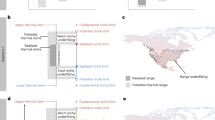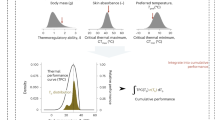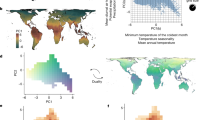Abstract
Global patterns of species range and richness are a consequence of many interacting factors, including environmental conditions, competition, geographical area, and historical/evolutionary development. Two widely studied global patterns of distribution are the latitudinal and elevation gradients of species range and richness. The fundamental mechanisms by which environment and physiology of the plants themselves interact to generate global-scale correlations between increased species range or decreased species richness and latitude/elevation have not previously been established. This paper develops the hypothesis that the primary climatic variables determining global-scale gradients in ectotherm species range and richness are temperature (T) and temperature variability (ΔT), and that the primary physiological variable defining adaptation of ectotherms to temperature is respiratory energy metabolism. This hypothesis is based on a postulate that adaptation of ectotherms to latitudinal/altitudinal gradients of T and ΔT leads to corresponding gradients in properties of energy metabolism. The gradients of metabolic properties give rise to gradients of species range and richness that are observed on a global scale. We demonstrate that natural selection results in ectotherms with metabolic properties matched to their environment and that energy use efficiency and the temperature range allowing growth are inversely related. Thus, opposing selective pressures to increase metabolic energy-use-efficiency or to increase the probability of surviving climate extremes control adaptation of ectotherms to climate. The principles developed in this paper yield fundamental laws of ecology that allow calculation of the contributions of global temperature patterns to the formation of gradients of species range and diversity. Relative values of richness and range are calculated solely from data on abiotic variables. Predictions agree with known patterns of ectotherm distribution.
Similar content being viewed by others
REFERENCES
Preston, F.W., The Commonness and Rarity of Species, Ecology, 1948, vol. 29, pp. 254-283.
Stehli, F.G., Douglas, R.G., and Newell, N.D., Generation and Maintenance of Gradients in Taxonomic Diversity, Science, 1969, vol. 164, pp. 947-949.
Huston, M., A General Hypothesis of Species Diversity, Am. Naturalist, 1979, vol. 113, pp. 81-101.
Brown, J.H., Two Decades of Homage to Santa Rosalia: towards a General Theory of Diversity, Am. Zoologist, 1981, vol. 21, pp. 877-888.
Stevens, G.C., The Latitudinal Gradient in Geographical Range: How so Many Species Coexist in the Tropics, Am. Naturalist, 1989, vol. 140, pp. 893-911.
Rohde, K., Latitudinal Gradients in Species Diversity: The Search for the Primary Cause, Oikos, 1992, vol. 65, pp. 514-527.
Rohde, K., The Larger Area of the Tropics Does Not Explain Latitudinal Gradients in Species Diversity, Oikos, 1997, vol. 79, pp. 169-172.
Begon, M., Harper, J.L., and Townsend, C.R., Ecology: Individuals, Populations, and Communities, Oxford: Blackwell Sci., 1996.
Currie, D.J., Francis, A.P., and Kerr, J.T., Some General Propositions about the Study of Spatial Patterns of Species Richness, Ecoscience, 1999, vol. 6, pp. 392-399.
Gaston, K.J., Why Rapaport's Rule Does Not Generalize, Oikos, 1999, vol. 84, pp. 309-312.
Pianka, E.R., Latitudinal Gradients in Species Diversity: A Review of Concepts, Am. Naturalist, 1996, vol. 100, pp. 33-46.
Rhode, K., Latitudinal Gradients in Species Diversity and Rapoport's Rule Revisited: A Review of Recent Work and What Can Parasites Teach Us about the Causes of the Gradients? Ecography, 1999, vol. 22, pp. 593-613.
Turner, J.R., Gatehouse, C.M., and Corey, C.A., Does Solar Energy Control Organic Diversity? Butterflies, Moths, and British Climate, Oikos, 1987, vol. 46, pp. 195-205.
Körner, Ch., Alpine Plants: Stressed or Adapted? Physiological Plant Ecology, Press, M.C. et al., Eds., Oxford: Blackwell Sci., 1999, pp. 297-311.
Rosenzweig, M.L., Species Diversity in Space and Time, Cambridge: Cambridge Univ. Press, 1995.
Criddle, R.S., Hopkins, M., McArthur, E.D., and Hansen, L.D., Plant Distribution and the Temperature Coefficient of Metabolism, Plant Cell Environ., 1994, vol. 17, pp. 233-243.
Criddle, R.S., Anekonda, T.S., and Hansen, L.D., Selection for Biomass Production Based on Respiration Parameters in Eucalypts: Acclimation of Growth and Respiration to Changing Growth Conditions, Can. J. Forest Res., 1996, vol. 26, pp. 1569-1575.
Criddle, R.S., Breidenbach, R.W., Fontana, A.J., Henry, J.-M., Smith, B.N., and Hansen, L.D., Plant Respiration Responses to Climate Determine Geographic Distribution, Fiziol. Rast. (Moscow), 1996, vol. 43, pp. 813-820 (Russ. J. Plant Physiol., Engl. Transl.).
Criddle, R.S., Smith, B.N., and Hansen, L.D., A Respiration Based Description of Plant Growth Rate Responses to Temperature, Planta, 1997, vol. 201, pp. 441-445.
Clausen, J., Keck, D.D., and Hiesey, W.M., Experimental Studies on the Nature of Species: 3. Environmental Responses of Climatic Races of Achillea, Washington: Carnegie Inst. Pub. 581, 1948.
Pahlich, E., Plant Stress: The Adaptive Potential of Dynamic Systems, Progr. Bot., 1995, vol. 56, pp. 165-199.
Hansen, L.D., Hopkin, M.S., Rank, D.R., Anekonda, R.S., Breidenbach, R.W., and Criddle, R.S., The Relation between Plant Growth and Respiration: A Thermodynamic Model, Planta, 1994, vol. 185, pp. 756-782.
Church, J.N., Tests of the Ability of a Respiration Based Model to Predict Growth Rates and Adaptation to Specific Temperature Conditions: Studies on Pinus ponderosa, Eucalyptus Species and Sequoia Species, PhD thesis, Davis: Univ. California, 2000.
Harshman, L.G., Hoffman, A.A., and Clark, A.G., Selection for Starvation Resistance in Drosophila melanogaster: Physiological Correlates, Enzyme Activities and Multiple Stress Responses, J. Evol. Biol., 1999, vol. 12, pp. 370-379.
Whittaker, R.H., Communities and Ecosystems, New York: Macmillan, 1970, p. 30.
Stiling, P., Introductory Ecology, Prentice Hall, NJ: Englewood Cliffs, 1992, pp. 198-200.
Den Boer, P.J., Natural Selection or the Non-Survival of the Non-Fit, Acta Biotheor., 1999, vol. 47, pp. 83-97.
Ackerly, D.C., Dudley, S.A., Sultan, S.E., Schmitt, J., Coleman, J.S., Linder, C.R., Sandquist, D.R., Geber, M.A., Evans, A.S., Dawson, T.E., and Lechowicz, M.J., The Evolution of Plant Ecophysiological Traits: Recent Advances and Future Directions, BioScience, 2000, vol. 50, pp. 979-995.
Fraser, R.H. and Currie, D.J., The Species Richness-Energy Hypothesis in a System where Historical Factors Are Thought to Prevail: Coral Reefs, Am. Naturalist, 1996, vol. 148, pp. 138-159.
Author information
Authors and Affiliations
Rights and permissions
About this article
Cite this article
Criddle, R.S., Church, J.N., Smith, B.N. et al. Fundamental Causes of the Global Patterns of Species Range and Richness1. Russian Journal of Plant Physiology 50, 192–199 (2003). https://doi.org/10.1023/A:1022969029867
Issue Date:
DOI: https://doi.org/10.1023/A:1022969029867




